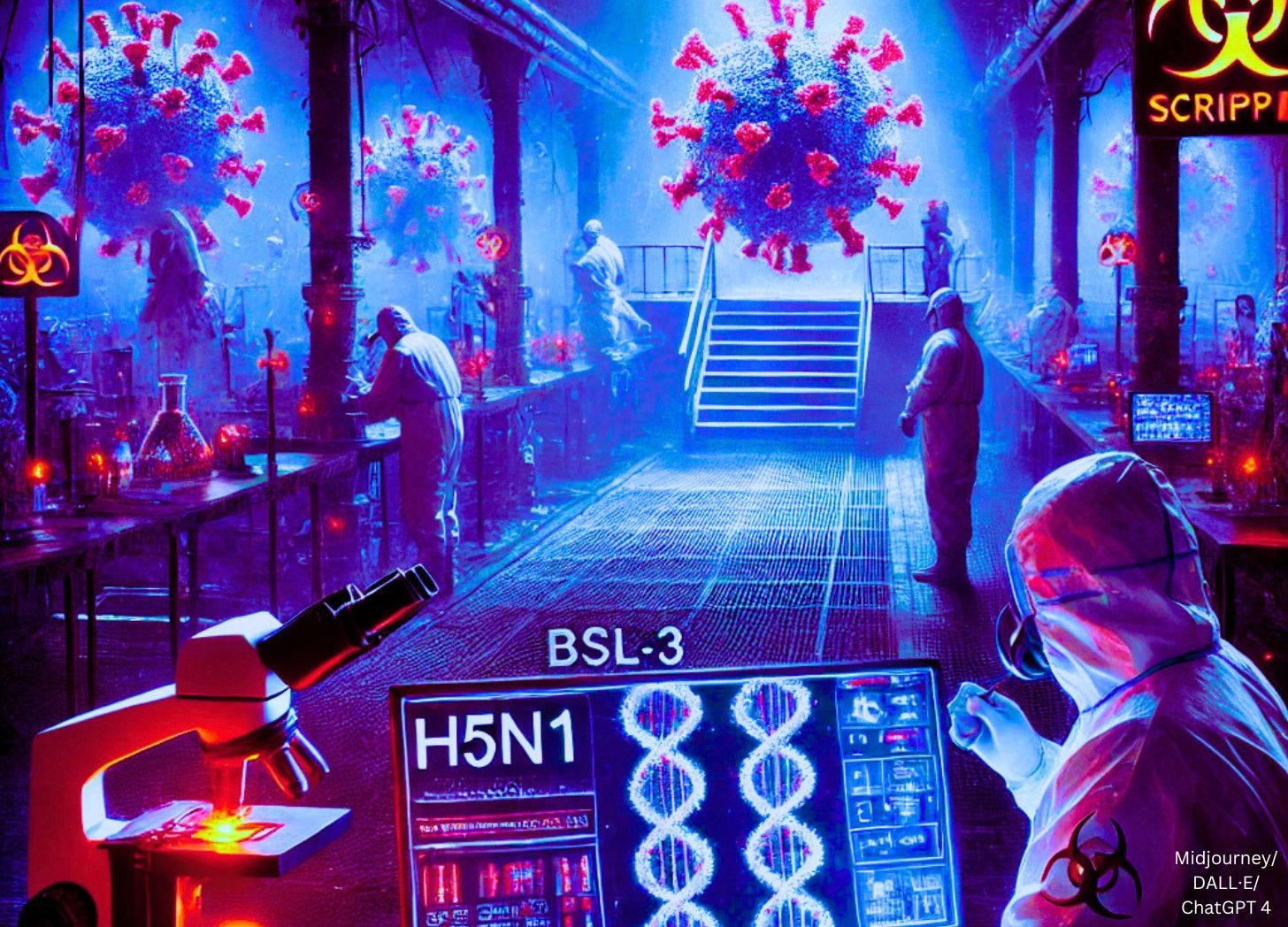California NIH/Bill Gates-Funded BSL-3 Biolab Mutates H5N1 Bird Flu Virus with Gain-of Function Experiments: Journal 'Science'
San Diego's Scripps Research Institute criticized for "publishing flu recipe for next pandemic."
A new research article published last week in Science reveals that scientists at Scripps Research in California are performing risky gain-of-function experiments on H5N1 avian influenza viruses to make them more dangerous to humans, potentially causing another pandemic.
Follow Jon Fleetwood: Instagram @realjonfleetwood / Twitter @JonMFleetwood / Facebook @realjonfleetwood
Researchers have deliberately engineered the highly pathogenic H5N1 bird flu virus to bind human receptors with a single genetic mutation, making it more capable of infecting humans.
This alarming manipulation, achieved by altering the hemagglutinin protein from the “first-reported human-infecting bovine H5N1 virus,” shifts the virus’s natural preference from birds to humans, a crucial step toward potential human-to-human transmission.
The paper reads:
In this study, analysis of the hemagglutinin (HA) from the first-reported human-infecting bovine H5N1 virus (A/Texas/37/2024, Texas) revealed avian-type receptor binding preference. Notably, a Gln226Leu substitution switched Texas HA binding specificity to human-type receptors, which was enhanced when combined with an Asn224Lys mutation. Crystal structures of the Texas HA with avian receptor analog LSTa and its Gln226Leu mutant with human receptor analog LSTc elucidated the structural basis for this preferential receptor recognition.
Scientists introduced mutations into the Texas H5N1 virus to test its ability to bind human cells, using advanced assays and crystal structure analysis to understand how these changes enhance its infectivity.
To assess the potential for the recent 2.3.4.4b viruses to acquire human-type receptor specificity, we introduced mutations into the receptor binding site (RBS) of the Texas HA protein and assessed receptor binding using surface plasmon resonance (SPR), enzyme-linked immunosorbent assay (ELISA), and glycan array analyses. Furthermore, we determined crystal structures for Texas H5 HA and its Gln226Leu mutant with avian and human receptor analogs to provide insights into the molecular basis of H5 HA receptor preference.
Avian flu viruses usually need multiple mutations to spread in humans.
However, the study authors’ work shows that the single mutation they caused can enable the Texas H5N1 virus to target human cells, significantly raising the risk of it evolving to spread between humans.
They write:
Because each mutation is independent and the probability of achieving additional mutations decreases exponentially, our observation that a single mutation is sufficient to switch receptor specificity in the Texas HA dramatically increases the likelihood of achieving this phenotype required for human transmission.
Co-senior author Dr. James Paulson, the Cecil H. and Ida M. Green Chair of Chemistry at Scripps Research, confirmed the gain-of-function experiment he performed on the virus “revealed that the Q226L mutation could significantly increase the virus’ ability to target and attach to human-type receptors.”
“This mutation gives the virus a foothold on human cells that it didn’t have before, which is why this finding is a red flag for possible adaptation to people,” Dr. Paulson added.
With the capability to spark a pandemic, this gain-of-function research highlights the disturbing ease with which a single tweak can transform a zoonotic virus into a direct threat to global public health.
You can read the full Science publication below:
NIH Funding Upgrades Scripps Biosafety Level Rating
Scripps Research is a well-known nonprofit biomedical research facility headquartered in San Diego.
It holds over 1,100 patents, has produced 11 FDA-approved therapeutics, and has generated over 50 spin-off companies.
The Institute is heavily funded by the U.S. National Institutes of Health (NIH), which financed gain-of-function research linked to the COVID-19 pandemic.
In 2023, NIH gave $54 million to Scripps, with an anticipated total funding of $282 million over five years.
The year prior, the Institute was awarded a $3.8 million NIH grant to upgrade its biosafety capabilities to a level 3 (BSL-3) rating.
It’s also significantly funded by the Bill & Melinda Gates Foundation (here, here, here, here, here, here, here).
BSL-3 labs work with pathogens including:
Mycobacterium tuberculosis, which causes tuberculosis;
Bacillus anthracis, the agent of anthrax;
Yersinia pestis, which causes plague;
Coxiella burnetii, which leads to Q fever;
Rickettsia rickettsii, the cause of Rocky Mountain spotted fever;
Francisella tularensis, responsible for tularemia;
Brucella species, known for causing brucellosis;
SARS-CoV-1, associated with Severe Acute Respiratory Syndrome (SARS);
Yellow fever virus, which causes yellow fever;
West Nile virus, responsible for West Nile fever;
MERS-CoV, linked to Middle East Respiratory Syndrome (MERS);
Rift Valley fever virus, responsible for Rift Valley fever;
Venezuelan equine encephalitis virus and Eastern equine encephalitis virus, both of which cause encephalitis in humans and animals;
Chikungunya virus, which causes chikungunya fever;
Chlamydia psittaci, which causes psittacosis.
Scripps Criticized for ‘Publishing Flu Recipe for Next Pandemic’
In an article by The Telegraph titled “Scientists under fire for publishing flu recipe for next pandemic in top journal,” experts are warning about the “biosafety implications of releasing the blueprint for creating a mutated bovine-bird flu virus.”
The Scripps scientists are being criticized for “publishing a blueprint to create a mutated bovine-bird flu virus that could cause another pandemic.”
The article notes how the H5N1 mutations increased the virus’s ability to bind to human cells to “near-pandemic levels.”
King’s College’s Dr. Fillipa Lentzos, a member of the UK Biosecurity Leadership Council, told The Telegraph:
“[I]n light of current debates about risky bioresearch, the paper should have addressed biosafety and biosecurity concerns head on as we clearly don’t want to accidentally seed a human-made pandemic or give people ideas of how to do so.”
“Responsible science needs to engage with these concerns.”
“We should of course anyway be preparing for bovine H5N1 to jump to humans so it is not clear the research adds much in terms of actually changing biopreparedness strategies.”
The article cited Col Retd Hamish de Bretton-Gordon OBE, an expert on chemical and biological counter-terrorism and a former British Army officer, who warned about labs sparking pandemics:
“You can splice Lassa fever with Covid and you’ve got a terrifying biological weapon – much more terrifying than anthrax or even smallpox,” he said. “In the wrong hands for nefarious reasons, it could be disastrous. This is WMD (weapons of mass destruction) stuff.”
Lord Vallance, the U.K.’s Minister of State for Science in the United Kingdom, warned that “there are potential misuses of biology” and that “somebody might be inappropriately asking for things” that can “potentially [be] used for inappropriate purposes.”
Follow Jon Fleetwood: Instagram @realjonfleetwood / Twitter @JonMFleetwood / Facebook @realjonfleetwood


















Extremely disturbing.
How come people like him are not indicted and prosecuted?